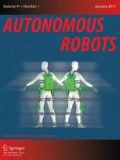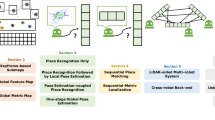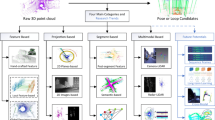Abstract
Introducing a priori knowledge about the latent structure of the environment in simultaneous localization and mapping (SLAM), can improve the quality and consistency results of its solutions. In this paper we describe and analyze a general framework for the detection, evaluation, incorporation and removal of structure constraints into a feature-based graph formulation of SLAM. We specifically show how including different kinds and levels of features in a hierarchical manner allows the system to easily discover new structure and why it makes more sense than other possible representations. The main algorithm in this framework follows an expectation maximization approach to iteratively infer the most probable structure and the most probable map. Experimental results show how this approach is suitable for the integration of a large variety of constraints and how our method can produce nice and consistent maps in regular environments.




















Similar content being viewed by others
References
Bailey, T., & Durrant-Whyte, H. (2006). Simultaneous localization and mapping (SLAM): Part II. IEEE Robotics & Automation Magazine, 13, 108–117.
Beevers, K., & Huang, W. (2008). Algorithmic foundations of robotics VII. Chap inferring and enforcing relative constraints in SLAM. Berlin, Heidelberg:Springer.
Carlin, B., & Louis, T. (2000). Bayes and empirical Bayes methods for data analysis texts. Statistical science. Boca Raton: Chapman & Hall/CRC.
Carlone, L., Aragues, R., Castellanos, J., & Bona, B. (2011). A linear approximation for graph-based simultaneous localization and mapping. In Proceedings of Robotics: Science and Systems, Los Angeles, CA, USA.
Castellanos, J. A., Montiel, J. M. M., Neira, J., & Tardos, J. D. (1999). The SPmap: a probabilistic framework for simultaneous localization and map building. IEEE Transactions on Robotics and Automation, 15, 948–953.
Chong, K., & Kleeman, L. (1997). Sonar based map building for a mobile robot. In Proceedings of the IEEE International Conference on Robotics and Automation (ICRA).
D’Agostino, R. B., Belanger, A., & D’Agostino, J. (1990). A suggestion for using powerful and informative tests of normality. The American Statistician, 44(4), 316–321.
Davis, T. A. (2006). Direct methods for sparse linear systems (fundamentals of algorithms 2). Philadelphia: Society for Industrial and Applied Mathematics.
Dellaert, F. (2005). Square root SAM: Simultaneous localization and mapping via square root information smoothing. In Proceedings of the Robotics: Science and Systems I (RSS).
Dempster, A., Laird, N., & Rubin, D. (1977). Maximum likelihood from incomplete data via the EM algorithm. Journal of the Royal Statistical Society Series B, 39(1), 1–38.
Dolgov, D., & Thrun, S. (2008). Detection of principal directions in unknown environments for autonomous navigation. In Proceedings of the Robotics: Science and Systems IV (RSS).
Duda, R., & Hart, P. (1972). Use of the Hough transformation to detect lines and curves in pictures. Communications of the ACM, 15, 11–15.
Durrant-Whyte, H., & Bailey, T. (2006). Simultaneous localization and mapping (SLAM): Part I. In IEEE Robotics & Automation Magazine (pp. 99–108).
Fischler, M., & Bolles, R. (1981). Random sample consensus: A paradigm for model fitting with applications to image analysis and automated cartography. Communications of the ACM, 24(6), 381–395.
Folkesson, J., Jensfelt, P., & Christensen, H. I. (2007). The M-space feature representation for SLAM. IEEE Transactions on Robotics, 23(5), 106–115.
Galindo, C., Saffiotti, A., Coradeschi, S., Buschka, P., Fernandez-Madrigal, J., & Gonzalez, J. (2005). Multi-hierarchical semantic maps for mobile robotics. In Proceedings of the IEEE International Conference on Intelligent Robots and Systems (IROS).
Gallup, D., Frahm, J. M., & Pollefeys, M. (2010). Piecewise planar and non-planar stereo for urban scene reconstruction. In CVPR, IEEE (pp. 1418–1425).
Grisetti, G., Stachniss, C., & Burgard, W. (2007). Improved techniques for grid mapping with Rao-Blackwellized particle filters. IEEE Transactions on Robotics, 23(1), 34–46.
Grisetti, G., Stachniss, C., Grzonka, S., & Burgard, W. (2007). A tree parameterization for efficiently computing maximum likelihood maps using gradient descent. In Proceedings of Robotics, Science and Systems III (RSS).
Grisetti, G., Stachniss, C., & Burgard, W. (2009). Non-linear constraint network optimization for efficient map learning. In IEEE Transactions on Intelligent Transportation Systems (p. 2009).
Grisetti, G., Kümmerle, R., Stachniss, C., & Burgard, W. (2010). A tutorial on graph-based SLAM. IEEE Intelligent Transportation Systems Magazine, 2(4), 31–43.
Grisetti, G., Kümmerle, R., Stachniss, C., Frese, U., & Hertzberg, C. (2010). Hierarchical optimization on manifolds for online 2d and 3d mapping. In Proceedings of the IEEE International Conference on Robotics and Automation (ICRA).
Howard, A., & Roy, N. (2003). The robotics data set repository (radish). Retrieved February 8, 2014 from http://radish.sourceforge.net/.
Huber, P. J. (1981). Robust statistics. New York: Wiley.
Kaess, M., Ranganathan, A., & Dellaert, F. (2008). iSAM: Incremental smoothing and mapping. IEEE Transactions on Robotics, 24(6), 1365–1378.
Karg, M., Wurm, K., Stachniss, C., Dietmayer, K., & Burgard, W. (2010). Consistent mapping of multistory buildings by introducing global constraints to graph-based SLAM. In Proceedings of the IEEE Internaional Conference on Robotics and Automation (ICRA).
Krieg-Brückner, B., Frese, U., Lüttich, K., Mandel, C., Mossakowski, T., & Ross, R. J. (2004). Specification of an ontology for route graphs. In C. Freksa, M. Knauff, B. Krieg-Brückner, B. Nebel, & T. Barkowsky (Eds.), Spatial cognition. Lecture Notes in Computer Science (Vol. 3343, pp. 390–412). Berlin: Springer.
Kuemmerle, R., Grisetti, G., Strasdat, H., Konolige, K., & Burgard, W. (2011). g\(^2\)o: A general framework for graph optimization. In Proceedings of the IEEE International Conference on Robotics and Automation (ICRA).
Kuipers, B. (2000). The spatial semantic hierarchy. Artificial Intelligence, 19, 191–233.
Kümmerle, R., Steder, B., Dornhege, C., Ruhnke, M., Grisetti, G., Stachniss, C., et al. (2009). On measuring the accuracy of SLAM algorithms. Journal of Autonomous Robots, 27, 387.
Kümmerle, R., Steder, B., Dornhege, C., Kleiner, A., Grisetti, G., & Burgard, W. (2011). Large scale graph-based SLAM using aerial images as prior information. Journal of Autonomous Robots, 30(1), 25–39. doi:10.1007/s10514-010-9204-1.
Liu, Y., & Thrun, S. (2002). Results for outdoor-SLAM using sparse extended information filters. In Proceedings of the IEEE International Conference on Robotics and Automation (ICRA) (pp. 1227–1233).
Lu, F., & Milios, E. (1997). Globally consistent range scan alignment for environment mapping. Autonomous Robots, 4, 333–349.
Newcombe, R., Lovegrove, S., & Davison, A. (2011). DTAM: Dense tracking and mapping in real-time. In ICCV (pp. 2320–2327).
Nguyen, V., & Harati, A. (2007). A lightweight SLAM algorithm using orthogonal planes for indoor mobile robotics. In Proceedings of the IEEE International Conference on Intelligent Robots and Systems (IROS).
Olson, E. (2008). Robust and efficient robotic mapping. Ph. D Thesis, Massachusetts Institute of Technology, Cambridge, MA, USA.
Olson, E. (2009). Recognizing places using spectrally clustered local matches. Robotics and Autonomous Systems, 57(12), 1157–1172.
Olson, E., Leonard, J., & Teller, S. (2006). Fast iterative optimization of pose graphs with poor initial estimates. In Proceedings of the IEEE International Conference on Robotics and Automation (ICRA).
Parsley, M., & Julier, S. (2010). Towards the exploitation of prior information in SLAM. In Proceedings of the IEEE International Conference on Intelligent Robots and Systems (IROS).
Parsley, M., & Julier, S. (2011). Exploiting prior information in GraphSLAM. In Proceedings of the IEEE International Conference on Robotics and Automation (ICRA).
Ponsa, D., & Roca, X. (2002). Unsupervised parameterisation of Gaussian mixture models. In M. Escrig, F. Toledo, & E. Golobardes (Eds.), Topics in artificial intelligence. Lecture Notes in Computer Science (Vol. 2504, pp. 388–398). Berlin, Heidelberg: Springer.
de la Puente, P. (2012). Probabilistic mapping with mobile robots in structured environments. Ph. D Thesis, Universidad Politécnica de Madrid.
de la Puente, P., Censi, A. (2012). Dense map inference with user-defined priors: from priorlets to scan eigenvariations. In C. Stachniss, K. Schill, & D. Uttal (Eds.), Proceedings of Spatial Cognition VIII. Lecture Notes in Computer Science (Vol. 7463, pp. 94–113). Berlin: Springer.
Rodríguez-Losada, D., Matía, F., Jiménez, A., & Galán, R. (2006). Consistency improvement for SLAM-EKF for indoor environments. In Proceedings of the IEEE International Conference on Robotics and Automation (ICRA).
Smith, R., & Cheeseman, P. (1986). On the representation and estimation of spatial uncertainly. International Journal Robotics Research, 5(4), 56–68.
Thrun, S., & Montemerlo, M. (2006). The GraphSLAM algorithm with applications to large-scale mapping of urban structures. International Journal Robotics Research, 25, 403–429.
Thrun, S., Burgard, W., & Fox, D. (2005). Probabilistic robotics. Cambridge: MIT.
Trevor, A., Rogers, J., Nieto, C., & Christensen, H. (2010). Applying domain knowledge to SLAM using virtual measurements. In Proceedings of the IEEE International Conference on Robotics and Automation (ICRA).
Walter, M. R., Eustice, R. M., & Leonard, J. J. (2007). Exactly sparse extended information filters for feature-based SLAM. International Journal of Robotics Research, 26(4), 335–359.
Acknowledgments
The authors would like to thank Mike Bosse for collecting and sharing the Killian Court data set. Thanks go to Dieter Fox for providing the Intel Research Lab data. This data set was obtained from the Robotics Data Set Repository (Radish) (Howard and Roy 2003). This work was supported in part by Comunidad de Madrid and European Social Fund (ESF) programs and also by the Spanish Ministry of Science and Technology, DPI2010-21247-C02-01—ARABOT (Autonomous Rational Robots).
Author information
Authors and Affiliations
Corresponding author
Rights and permissions
About this article
Cite this article
de la Puente, P., Rodriguez-Losada, D. Feature based graph-SLAM in structured environments. Auton Robot 37, 243–260 (2014). https://doi.org/10.1007/s10514-014-9386-z
Received:
Accepted:
Published:
Issue Date:
DOI: https://doi.org/10.1007/s10514-014-9386-z




